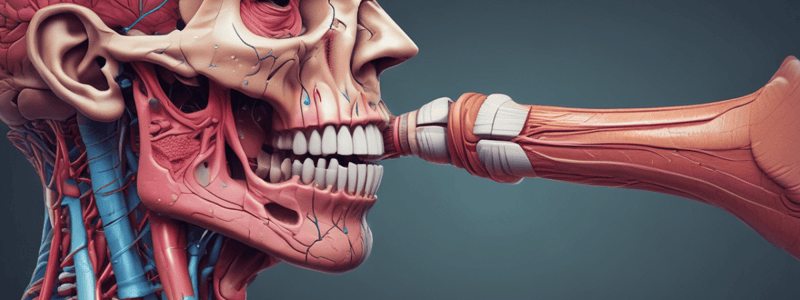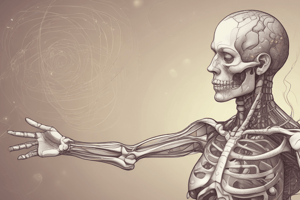Podcast
Questions and Answers
Which of the following muscles elevates the larynx and the pharynx during swallowing?
Which of the following muscles elevates the larynx and the pharynx during swallowing?
- Salpingopharyngeus
- Palatopharyngeus
- Stylopharyngeus
- All of the above (correct)
Which nerve innervates the stylopharyngeus muscle, the only pharyngeal muscle not innervated by the vagus nerve?
Which nerve innervates the stylopharyngeus muscle, the only pharyngeal muscle not innervated by the vagus nerve?
- Hypoglossal nerve
- Glossopharyngeal nerve (correct)
- Accessory nerve
- Facial nerve
Which of the following arteries supplies blood to the palatine tonsil at its lower pole?
Which of the following arteries supplies blood to the palatine tonsil at its lower pole?
- Tonsillar branch of the facial artery
- Tonsillar branch of the ascending palatine artery
- Ascending pharyngeal artery
- Both A and B (correct)
Which layer of the pharynx is responsible for initiating the gag reflex?
Which layer of the pharynx is responsible for initiating the gag reflex?
Which of the following structures is not a part of the laryngopharynx?
Which of the following structures is not a part of the laryngopharynx?
What is the function of the pharyngeal tonsil?
What is the function of the pharyngeal tonsil?
Which fold covers the salpingopharyngeus muscle in the oropharynx?
Which fold covers the salpingopharyngeus muscle in the oropharynx?
Where is the pharyngeal opening of the auditory (Eustachian) tube located?
Where is the pharyngeal opening of the auditory (Eustachian) tube located?
Which structure marks the boundary between the oropharynx and the laryngopharynx?
Which structure marks the boundary between the oropharynx and the laryngopharynx?
In which region of the pharynx does the laryngopharynx extend to?
In which region of the pharynx does the laryngopharynx extend to?
What is the primary function of the pharyngeal constrictor muscles?
What is the primary function of the pharyngeal constrictor muscles?
Which of the following statements about the pharyngeal tonsils is INCORRECT?
Which of the following statements about the pharyngeal tonsils is INCORRECT?
Which lymph node group primarily drains the pharyngeal tonsils?
Which lymph node group primarily drains the pharyngeal tonsils?
Which of the following structures is NOT part of the pharyngeal plexus?
Which of the following structures is NOT part of the pharyngeal plexus?
Match the following pharyngeal muscles with their innervating nerve:
Match the following pharyngeal muscles with their innervating nerve:
Match the following arteries with their role in supplying blood to the pharynx:
Match the following arteries with their role in supplying blood to the pharynx:
Match the following muscles with their function during swallowing:
Match the following muscles with their function during swallowing:
Match the part of the pharynx with its description:
Match the part of the pharynx with its description:
Match the structure with its function in deglutition (swallowing):
Match the structure with its function in deglutition (swallowing):
Match the muscle with its action in deglutition (swallowing):
Match the muscle with its action in deglutition (swallowing):
Match the tonsil with its innervating nerve:
Match the tonsil with its innervating nerve:
Match the lymphatic drainage route with the corresponding pharyngeal region:
Match the lymphatic drainage route with the corresponding pharyngeal region:
Match the structure with its location within the pharynx during deglutition (swallowing):
Match the structure with its location within the pharynx during deglutition (swallowing):
Match the following veins with their drainage pathway in relation to the pharynx:
Match the following veins with their drainage pathway in relation to the pharynx:
Flashcards
What are the two main divisions of the respiratory system?
What are the two main divisions of the respiratory system?
The respiratory system is divided into the upper and lower respiratory systems. The upper respiratory system includes the structures above the larynx, while the lower respiratory system includes the structures below the larynx.
What structures are part of the upper respiratory system?
What structures are part of the upper respiratory system?
The upper respiratory system includes the paranasal sinuses, nasal conchae, nose, nasal cavity, posterior nasal apertures, nasopharynx, tongue, and hyoid bone.
What structures are part of the lower respiratory system?
What structures are part of the lower respiratory system?
The lower respiratory system includes the larynx, esophagus, trachea, bronchi, lungs, clavicle, bronchioles, right lung, ribs, left lung, and diaphragm.
What is the pharynx and where is it located?
What is the pharynx and where is it located?
Signup and view all the flashcards
What makes up the pharynx and how is it divided?
What makes up the pharynx and how is it divided?
Signup and view all the flashcards
What is the nasopharynx and what does it contain?
What is the nasopharynx and what does it contain?
Signup and view all the flashcards
What is the oropharynx and what does it contain?
What is the oropharynx and what does it contain?
Signup and view all the flashcards
What is the laryngopharynx and where is it located?
What is the laryngopharynx and where is it located?
Signup and view all the flashcards
What are the pharyngeal muscles and what do they do?
What are the pharyngeal muscles and what do they do?
Signup and view all the flashcards
What are the blood vessels of the pharynx?
What are the blood vessels of the pharynx?
Signup and view all the flashcards
What is the pharyngeal plexus and what does it innervate?
What is the pharyngeal plexus and what does it innervate?
Signup and view all the flashcards
What are the palatine tonsils and how are they supplied?
What are the palatine tonsils and how are they supplied?
Signup and view all the flashcards
Where is lymphoid tissue found in the pharynx and what is its function?
Where is lymphoid tissue found in the pharynx and what is its function?
Signup and view all the flashcards
What is the main function of the respiratory system?
What is the main function of the respiratory system?
Signup and view all the flashcards
What is the role of the upper respiratory system in breathing?
What is the role of the upper respiratory system in breathing?
Signup and view all the flashcards
Where does gas exchange occur in the respiratory system?
Where does gas exchange occur in the respiratory system?
Signup and view all the flashcards
What is the larynx and what does it contain?
What is the larynx and what does it contain?
Signup and view all the flashcards
What is the trachea and what is it made of?
What is the trachea and what is it made of?
Signup and view all the flashcards
What are the bronchi and what do they do?
What are the bronchi and what do they do?
Signup and view all the flashcards
What are the lungs and where are they located?
What are the lungs and where are they located?
Signup and view all the flashcards
What is the diaphragm and what does it do?
What is the diaphragm and what does it do?
Signup and view all the flashcards
What are alveoli and what happens there?
What are alveoli and what happens there?
Signup and view all the flashcards
What is breathing and why is it important?
What is breathing and why is it important?
Signup and view all the flashcards
Study Notes
The Respiratory System
- The respiratory system consists of the upper respiratory system and lower respiratory system
- Upper respiratory system: paranasal sinuses, nasal conchae, nose, nasal cavity, posterior nasal apertures, nasopharynx, tongue, hyoid bone
- Lower respiratory system: larynx, esophagus, trachea, bronchi, lungs, clavicle, bronchioles, right lung, ribs, left lung, diaphragm
The Pharynx
- The pharynx is a passageway that connects the nose to the mouth to the throat
- Begins at the base of the skull to the inferior border of the cricoid cartilage (C6) where it continues with the esophagus
- Composed of skeletal muscle and mucous membranes
- Divided into three parts: nasopharynx, oropharynx, and laryngopharynx
Nasopharynx
- Lies posterior to the nasal cavity and extends to the soft palate
- Contains the pharyngeal opening of the auditory (Eustachian) tube
- Pharyngeal tonsil (adenoids when enlarged) and concentrations of lymphoid tissue in the mucous membrane of the roof and posterior nasopharynx
Oropharynx
- Has a digestive function and extends from the soft palate to the superior border of the epiglottis
- Consists of the pharyngeal arch and uvula
- Contains the salpingopharyngeal fold, which covers the salpingopharyngeus muscle
- Soft palate forms the posterior portion of the roof of the mouth
Laryngopharynx
- The area that has the entrance to the trachea and esophagus
- Extends from the superior border of the epiglottis to the inferior border of the cricoid cartilage where it is continuous with the esophagus
- Posterior to the larynx
Pharyngeal Muscles
- External circular layer and internal longitudinal layer
- Innervated by the vagus nerve (CN X) and glossopharyngeal nerve (CN IX)
- Elevate the larynx and the pharynx during swallowing
Vessels of the Pharynx
- Arteries: ascending pharyngeal, superior thyroid, ascending and descending palatine, and pharyngeal branches of the maxillary artery
- Veins: pharyngeal venous plexus drains into internal jugular vein
- Arteries to the palatine tonsil: tonsillar branch of facial, ascending palatine, and dorsal lingual arteries
Pharyngeal Plexus
- Formed by the glossopharyngeal nerve (CN IX), vagus nerve (CN X), and postganglionic sympathetic fibers from the superior cervical ganglion
- Innervates the pharyngeal constrictors and soft palate
Tonsils
- Palatine tonsil is innervated by the glossopharyngeal nerve (CN IX)
- Blood supply: tonsillar branch of facial, ascending palatine, and dorsal lingual arteries
- Lymphoid tissue in the tonsils, pharyngeal, and posterior nasal walls
- Part of Waldeyer's tonsillar ring, which includes the lingual tonsils, tubal tonsils, and pharyngeal tonsil
Studying That Suits You
Use AI to generate personalized quizzes and flashcards to suit your learning preferences.
Related Documents
Description
Test your knowledge on the anatomy of the pharynx, including the three parts - nasopharynx, oropharynx, and laryngopharynx. Learn about their structures and functions in relation to swallowing and the shared roles with the respiratory and digestive systems.




